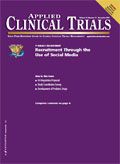Pediatric Drug Development
Applied Clinical Trials
A framework is needed to facilitate, promote, and reward basic and applied research for adults and children.
Pediatric legislation aims at letting children benefit more from pharmaceutical progress. The United States re-authorized it recently as FDASIA (FDA Safety & Innovation Act), the European Union one is in force since 2007. Drug developers have no choice anymore: they must consider children. Who could be against this?
Clinical trials in children had a bad reputation. This has changed. The need to test new treatments is generally accepted; strong safeguards protect children's rights in research. Diseases that were a death sentence decades ago are chronic conditions today in adults and children (e.g., cystic fibrosis (CF) or insulin-dependent diabetes). Children with CF died young half a century ago; today their life expectancy is >40 years. Almost 90 percent of children with acute lymphatic leukemia (ALL) survive, but 10 percent don't. Survivors and non-survivors often go through two or more rounds of chemotherapy, a nightmare for patient and family. We need a breakthrough here. It will come. Are therapeutic breakthroughs achieved through pediatric legislation? No. Pediatric legislation promotes gradual improvements: earlier availability of new adult drugs, better dose calculation, and improved drug safety. Breakthroughs come from a mixture of science, dedication, and the market. Without entrepreneurs there are no new drugs. Human curiosity and science continuously challenge our traditional understanding. To reach patients, new inventions must reach the market. Companies do that, not academia.

Klaus Rose
The medical market needs control to protect patients. Control should be balanced and not discourage innovation. US legislation balances mandatory requirements and incentives. EU emphasis is on mandatory requirements. The European Medicines Agency (EMA) will not register a new drug without a pediatric investigation plan (PIP) agreed with its pediatric committee (PDCO). PIPs should be submitted end of Phase I; their negotiation takes almost a year. The EU PIP procedure keeps many people busy: 66 PDCO members, 30 EMA pediatric coordinators and administrators; employees of 27 EU authorities; and people in industry, CROs, and consultancies. Even companies that develop drugs specifically for children must negotiate a PIP. The EU legislation originated in good intention; run by a bureaucracy with much power and little control, it starts to affect drug development. Companies will avoid therapeutic areas with extreme PDCO requests. Even the EU ombudsman criticizes EMA/PDCO for lack of transparency.
Drug development is expensive. Frequent diseases are more and more treated by generics; research-based pharmaceutical industry is increasingly targeting rare diseases. FDASIA mandates a conference to accelerate development of products for pediatric rare diseases. The debate how to balance costs and how to prioritize will intensify.
The more the societal framework allows the energy of parents, scientists, entrepreneurs, and clinicians to translate into new treatments, the faster breakthroughs will happen. Vision is a first step; there are many more steps until a new treatment reaches the market. It may begin with rocket science and/or common sense: a new receptor/antibody, a novel delivery device, a way to make research more child-friendly. We need a framework that facilitates, promotes, and rewards basic and applied research for adults and children. Blind trust into industry or academia or unlimited power to bureaucrats is not the right path. All institutions have hidden agendas. The debate will continue; at least we agree about the aim: better medicines, and children should benefit.
Klaus Rose Managing Director klausrose Consulting E-mail: klaus.rose@klausrose.net

FDA Fast Tracks Johnson & Johnson’s Nipocalimab for Fetal Neonatal Alloimmune Thrombocytopenia
March 27th 2024Johnson & Johnson is moving forward with a pair of Phase III trials of nipocalimab to reduce the risk of fetal neonatal alloimmune thrombocytopenia in alloimmunized pregnant patients.